The Science of Reading provides evidence-based approaches to teaching reading, emphasizing the critical role of vocabulary in literacy development. Research highlights how brain development, explicit instruction, and engaging practices foster word learning, enabling students to decode, comprehend, and connect with texts effectively, laying the foundation for lifelong reading growth and academic success.
What is the Science of Reading?
The Science of Reading is a research-based approach to reading instruction, focusing on how the brain processes language. It emphasizes phonics, decoding, and explicit teaching methods, ensuring all students, regardless of background, can learn to read effectively. By relying on proven strategies and structured techniques, it provides a comprehensive framework for educators to enhance reading skills and comprehension, benefiting both students and teachers through consistent and evidence-driven methods.
The Importance of Vocabulary in Reading Comprehension
Vocabulary is a cornerstone of reading comprehension, as it directly impacts a reader’s ability to understand and interpret texts. A robust vocabulary enhances fluency and allows students to engage deeply with complex material, fostering critical thinking and academic success. Research underscores that a strong vocabulary base bridges foundational skills and comprehension, making it essential for effective reading instruction and lifelong learning.
Key Findings from Research on Vocabulary Instruction
Research highlights that explicit vocabulary instruction significantly enhances reading comprehension and academic success. Studies show that intentional teaching of high-impact words, combined with interactive and engaging practices, fosters deeper understanding. Additionally, repeated exposure to words in meaningful contexts and differentiated instruction tailored to learner needs are critical. These strategies not only improve vocabulary retention but also address the diverse needs of students, ultimately closing the achievement gap and promoting lifelong literacy growth.
Foundational Concepts in Vocabulary Instruction
Vocabulary instruction relies on understanding word types, levels, and the role of background knowledge. Effective teaching connects new words to prior knowledge, enhancing comprehension and fluency.
Defining Vocabulary: Types and Levels
Vocabulary is categorized into tiers: Tier 1 (common words), Tier 2 (high-utility words), and Tier 3 (domain-specific terms). Understanding these levels helps tailor instruction, ensuring learners grasp essential words that bridge prior knowledge and new concepts, fostering deeper comprehension and linguistic fluency.
The Role of Background Knowledge in Vocabulary Acquisition
Background knowledge significantly enhances vocabulary acquisition by providing context and connections, enabling learners to anchor new words to existing understanding. This prior knowledge bridges gaps, aiding comprehension and retention, especially for complex or abstract terms, and fosters a deeper, more meaningful engagement with texts across various subjects and domains.
How Vocabulary Impacts Reading Fluency and Comprehension
Vocabulary knowledge is a cornerstone of reading fluency and comprehension, as it enables learners to decode and understand texts seamlessly. A robust vocabulary allows readers to process words automatically, freeing cognitive resources for deeper comprehension. Students with stronger vocabulary skills can access complex texts with greater ease, fostering engagement and academic success. Conversely, vocabulary gaps can hinder fluency and impede understanding, emphasizing the need for intentional, evidence-based vocabulary instruction to support overall literacy development and lifelong learning.
Brain Science and Vocabulary Learning
Brain research reveals that vocabulary learning engages specific neural pathways, with memory and retrieval playing crucial roles. Explicit instruction enhances word storage and retrieval efficiency, fostering long-term retention and effective use of vocabulary in reading and communication.
How the Brain Processes New Words
The brain processes new words by encoding them in neural pathways, linking sounds, meanings, and contexts. Research shows that repeated exposure and explicit instruction help solidify words in long-term memory, enabling quick retrieval during reading. Neuroimaging studies reveal that the left temporal lobe plays a key role in word recognition, while the hippocampus supports initial memory formation. Effective vocabulary instruction enhances these neural connections, fostering efficient word processing and comprehension.
The Role of Memory and Retrieval in Vocabulary Development
Memory and retrieval are central to vocabulary development, as words must be stored in long-term memory and efficiently retrieved for use. Research shows that retrieval practice strengthens memory traces, making words easier to access during reading. The hippocampus plays a key role in forming new word memories, while repeated exposure and practice move words from short-term to long-term storage. Explicit instruction and spaced practice enhance retrieval, building robust neural representations that support reading comprehension and lifelong vocabulary growth.

Effective Instructional Strategies
Effective instructional strategies blend explicit teaching, interactive practices, and differentiated approaches, ensuring all learners engage deeply with vocabulary, supported by evidence-based methods and teacher expertise.
Explicit Instruction: Teaching Words Directly
Explicit instruction involves directly teaching vocabulary through clear definitions, examples, and visual aids, ensuring students understand word meanings. Teachers model how to use words in sentences, reinforcing context and connections. This method is particularly effective for high-impact words critical to comprehension. Explicit teaching also includes spaced repetition and multisensory engagement to enhance retention. By focusing on direct instruction, educators provide foundational knowledge, enabling students to apply vocabulary in reading and writing, fostering both fluency and deeper understanding of texts.
Interactive and Engaging Vocabulary Practices
Interactive practices, such as word games, think-pair-share, and collaborative discussions, enhance vocabulary learning by making it dynamic and student-centered. These activities encourage active participation, fostering deeper word understanding and retention. Technology, like educational apps and digital flashcards, further engages learners through visually appealing and adaptive exercises. By integrating movement, creativity, and peer interaction, teachers create a motivating environment where students apply and reinforce new vocabulary, developing a strong foundation for reading and communication skills. Such methods ensure vocabulary instruction is both effective and enjoyable.
Differentiated Instruction for Diverse Learners
Differentiated instruction tailors vocabulary learning to meet the unique needs of all students. Strategies like tiered assignments, learning centers, and technology tools cater to varying skill levels. Teachers use scaffolded techniques, visual aids, and mnemonic devices to support learners. For English language learners, explicit instruction and culturally relevant examples bridge language gaps. Regular assessments and flexible grouping ensure personalized attention, fostering equitable access to vocabulary growth and ensuring no student is left behind in their reading journey.
Assessment and Feedback in Vocabulary Instruction
Effective vocabulary instruction relies on continuous assessment and feedback. Formative assessments monitor progress, while summative evaluations measure mastery, ensuring targeted support and fostering a growth-oriented learning environment.
Formative Assessments to Monitor Progress
Formative assessments are essential for monitoring students’ vocabulary growth and understanding throughout instruction. These ongoing evaluations, such as exit tickets, quizzes, and observation checklists, provide insights into students’ mastery of new words. Teachers can identify gaps in knowledge and adjust instruction accordingly. Regular feedback helps students refine their understanding and application of vocabulary. Technology, like educational apps, can also facilitate immediate feedback, ensuring learners stay on track and develop a robust vocabulary foundation. This approach supports personalized learning and fosters academic success.
Summative Assessments to Evaluate Mastery
Summative assessments are used to evaluate students’ mastery of vocabulary at the end of instructional periods. These assessments, such as unit tests or final projects, measure long-term retention and application of vocabulary. They provide a comprehensive understanding of students’ ability to use words accurately in context. Results from summative assessments help teachers determine if instructional goals have been met and inform future lesson planning. Technology, like AI-driven platforms, can offer detailed feedback, ensuring students achieve lasting vocabulary mastery and readiness for advanced learning. These evaluations are crucial for tracking progress and guiding systemic improvements in vocabulary instruction.
Technology and Digital Tools
Technology enhances vocabulary instruction through educational apps, AI-driven platforms, and adaptive learning tools. These resources provide interactive, personalized learning experiences, making vocabulary acquisition engaging and effective for all learners.
Using Educational Apps for Vocabulary Practice
Educational apps offer interactive and engaging ways to practice vocabulary, making learning fun and accessible. These tools often incorporate gamification, quizzes, and spaced repetition to reinforce word retention. Many apps provide personalized learning paths, adapting to individual student needs and progress. They also offer real-time feedback, helping students track their growth. By leveraging technology, apps can reach diverse learners, including English language learners and disadvantaged students, ensuring equitable access to vocabulary instruction. This aligns with the Science of Reading principles by providing evidence-based, effective learning opportunities.
Integrating AI and Adaptive Learning Platforms
AI and adaptive learning platforms revolutionize vocabulary instruction by providing personalized, data-driven experiences. These tools use algorithms to assess individual learning needs, offering tailored lessons and real-time feedback. AI can simulate human-like interactions, fostering engagement and deeper understanding. Adaptive platforms ensure that learners receive content matched to their skill level, accelerating progress. They also enable teachers to track student growth and adjust instruction accordingly, supporting equitable access to high-quality vocabulary instruction for all learners, regardless of their background or abilities.

Equity and Access in Vocabulary Instruction
Ensuring equitable vocabulary instruction involves addressing systemic gaps, supporting English language learners, and providing resources for disadvantaged students to foster inclusive learning environments and opportunities.
Supporting English Language Learners
Supporting English language learners requires targeted strategies to bridge language gaps. Visual aids, scaffolding techniques, and culturally relevant texts enhance vocabulary acquisition. Explicit instruction, paired with opportunities for interactive practice, fosters confidence and comprehension. Integrating technology, such as educational apps, provides personalized learning paths. By addressing diverse linguistic backgrounds and promoting inclusive classrooms, educators ensure equitable access to vocabulary growth, helping ELLs build foundational skills for long-term academic success.
Addressing the Vocabulary Gap for Disadvantaged Students
Disadvantaged students often face a significant vocabulary gap due to limited exposure to rich linguistic environments. Targeted interventions, such as explicit instruction and interactive practices, can help bridge this divide. Providing access to high-quality texts, digital tools, and engaging activities fosters equitable learning opportunities. Systemic approaches, including teacher training and community partnerships, ensure sustained support. By addressing these disparities, educators can empower disadvantaged students to close the vocabulary gap, enhancing their reading comprehension and overall academic potential for long-term success.

Policy Implications and Systemic Change
Aligning curriculum with research-based practices and providing professional development for teachers are key steps in systemic change, ensuring all students receive effective reading and vocabulary instruction.
Aligning Curriculum with Research-Based Practices
Aligning curriculum with research-based practices ensures that reading and vocabulary instruction is grounded in evidence. Schools should adopt structured literacy approaches, emphasizing explicit teaching of phonics, vocabulary, and comprehension strategies. Teacher training programs must focus on the Science of Reading principles to ensure educators are equipped to deliver high-quality instruction. By integrating proven methodologies and continuously monitoring student progress, educational systems can create a cohesive framework that supports all learners, fostering a strong foundation for lifelong literacy and academic success.
Professional Development for Teachers
Professional development is crucial for equipping teachers with the skills to implement evidence-based reading and vocabulary instruction. Training programs should focus on the Science of Reading, structured literacy, and explicit teaching strategies. Ongoing support through workshops, coaching, and resources ensures educators remain updated on best practices. By prioritizing teacher knowledge and expertise, schools can foster a culture of effective instruction, leading to improved student outcomes in reading comprehension, vocabulary acquisition, and overall academic achievement, supported by continuous learning opportunities for educators.

Future Directions in Vocabulary Instruction
Future directions emphasize integrating AI-driven tools, adaptive learning platforms, and innovative teaching methodologies to enhance vocabulary acquisition, fostering engagement and personalized growth for all learners.
Innovative Approaches and Emerging Research
Emerging research highlights technology-driven strategies, such as AI-powered adaptive learning and interactive apps, to enhance vocabulary instruction. Innovative approaches like gamification and collaborative tasks are gaining traction, fostering engagement and deeper word understanding. Studies explore neuroscientific insights into how the brain processes vocabulary, informing more effective teaching methods. Personalized learning tools and real-time feedback systems are also being developed to cater to diverse learners, ensuring equitable access to high-quality vocabulary instruction and promoting lifelong language growth.
Preparing for a Lifelong Journey of Vocabulary Growth
Cultivating a love for reading and fostering curiosity are essential for lifelong vocabulary growth. Encouraging students to explore diverse texts and engage in discussions builds their confidence and language skills. Integrating technology, such as educational apps and AI-driven tools, provides personalized learning experiences that adapt to individual needs. By promoting active learning and celebrating small achievements, educators can empower students to embrace vocabulary acquisition as a continuous and rewarding journey, preparing them for future academic and personal success.
The Science of Reading underscores the transformative power of evidence-based vocabulary instruction in fostering literacy. By aligning teaching practices with research, educators can equip students with the tools to decode, comprehend, and connect with texts. Vocabulary growth, supported by explicit instruction and engaging strategies, is not just a skill but a gateway to lifelong learning. As we move forward, prioritizing these approaches ensures that all students, regardless of background, can thrive as confident, capable readers prepared for future challenges and opportunities.



























